
Mussel is the common name used for members of several families of bivalve molluscs, from saltwater and freshwater habitats. These groups have in common a shell whose outline is elongated and asymmetrical compared with other edible clams, which are often more or less rounded or oval.

Bivalvia, in previous centuries referred to as the Lamellibranchiata and Pelecypoda, is a class of marine and freshwater molluscs that have laterally compressed bodies enclosed by a shell consisting of two hinged parts. Bivalves as a group have no head and they lack some usual molluscan organs like the radula and the odontophore. They include the clams, oysters, cockles, mussels, scallops, and numerous other families that live in saltwater, as well as a number of families that live in freshwater. The majority are filter feeders. The gills have evolved into ctenidia, specialised organs for feeding and breathing. Most bivalves bury themselves in sediment where they are relatively safe from predation. Others lie on the sea floor or attach themselves to rocks or other hard surfaces. Some bivalves, such as the scallops and file shells, can swim. The shipworms bore into wood, clay, or stone and live inside these substances.

The Unionidae are a family of freshwater mussels, the largest in the order Unionida, the bivalve molluscs sometimes known as river mussels, or simply as unionids.

The freshwater pearl mussel is an endangered species of freshwater mussel, an aquatic bivalve mollusc in the family Margaritiferidae.

Unionida is a monophyletic order of freshwater mussels, aquatic bivalve molluscs. The order includes most of the larger freshwater mussels, including the freshwater pearl mussels. The most common families are the Unionidae and the Margaritiferidae. All have in common a larval stage that is temporarily parasitic on fish, nacreous shells, high in organic matter, that may crack upon drying out, and siphons too short to permit the animal to live deeply buried in sediment.

Cumberlandia monodonta is a freshwater mussel endemic to the United States. Currently, C. monodonta is listed as an endangered species by the U.S. Fish and Wildlife Service and the International Union for Conservation of Nature.

Lampsilis abrupta, the pink mucket or pink mucket pearly mussel, is a species of freshwater mussel, an aquatic bivalve mollusk in the family Unionidae, the river mussels. This species is endemic to the United States.
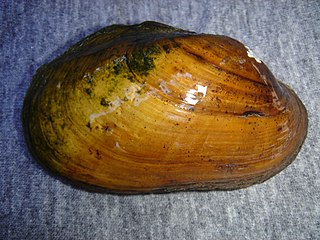
Lampsilis powellii is a rare species of freshwater mussel known by the common name Arkansas fatmucket. It is endemic to Arkansas in the United States, where it occurs in the Ouachita, Saline, and Caddo River systems. It is one of two mussels endemic to Arksansas, the other being speckled pocketbook. It is a federally listed threatened species of the United States.
Lampsilis rafinesqueana, the Neosho mucket or Neosho pearly mussel, is a species of North American freshwater mussel endemic to Arkansas, Oklahoma, Illinois, Missouri and Kansas.
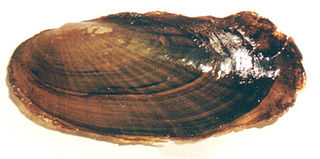
Leptodea leptodon, the scaleshell mussel or scale shell, is a species of freshwater mussel in the family Unionidae, the river mussels. This aquatic bivalve mollusk has disappeared from much of its historical range. It is endemic to the United States, where it is now present in four or fewer states; it is only found with any regularity in Missouri. It is a federally listed endangered species of the United States.

Margaritifera auricularia is a species of European freshwater mussel, an aquatic bivalve mollusk in the family Margaritiferidae, the freshwater pearl mussels. Formerly found throughout western and central Europe, the species is now critically endangered, being confined to a few rivers in Spain and France. M. auricularia is commonly known as Spengler's freshwater mussel in honour of Lorenz Spengler, who first described this species.
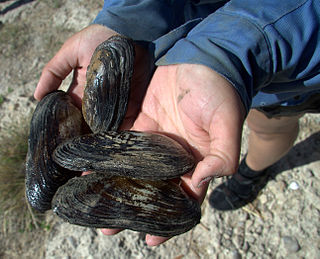
Popenaias popeii, common name the Texas hornshell, is a species of freshwater mussel, an aquatic bivalve mollusk in the family Unionidae, the river mussels.
The triangular kidneyshell is a species of freshwater mussel, in the family Unionidae, the river mussels. It is endemic to Alabama in the United States, where it is known from several rivers and streams in the Mobile River Basin. It is a federally listed endangered species of the United States.
Freshwater bivalves are one kind of freshwater mollusc, along with freshwater snails. They are bivalves which live in freshwater, as opposed to saltwater, the main habitat type for bivalves.

The glochidium is a microscopic larval stage of some freshwater mussels, aquatic bivalve mollusks in the families Unionidae and Margaritiferidae, the river mussels and European freshwater pearl mussels.
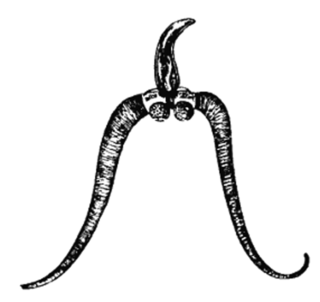
Bucephalus polymorphus is a type of flatworm. This species is within the Bucephalidae family of Digenea, which in turn is a subclass of Trematodes within the phylum Platyhelminthes. It is characterized by having a mouth near the middle of its body, along with a sac-like gut. The mouth opening is located in the centre of the ventral surface. This is a specific body type of cecaria known as a gastrostome.
Villosa arkansasensis, the Ouachita creekshell, is a species of freshwater mussel, an aquatic bivalve mollusc in the family Unionidae, the river mussels. It is endemic to certain rivers and streams in the Ouachita Mountains, Arkansas, and has a complex life history including its larvae being parasitic on a fish host.
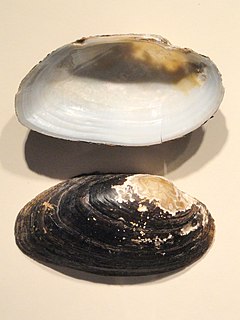
Strophitus undulatus is a species of mussel in the Unionidae, the river mussels. It is native to eastern Canada and the eastern United States. Its common names include creeper, squawfoot, sloughfoot, and strange floater.
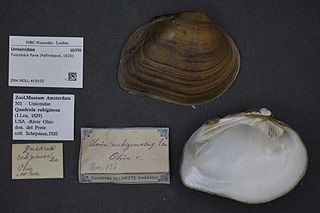
Fusconaia flava, the Wabash pigtoe, is a freshwater mussel in the family Unionidae.

Megalonaias nervosa is a freshwater mussel species in the family Unionidae. Washboard is the common name used for Megalonaias nervosa.
















